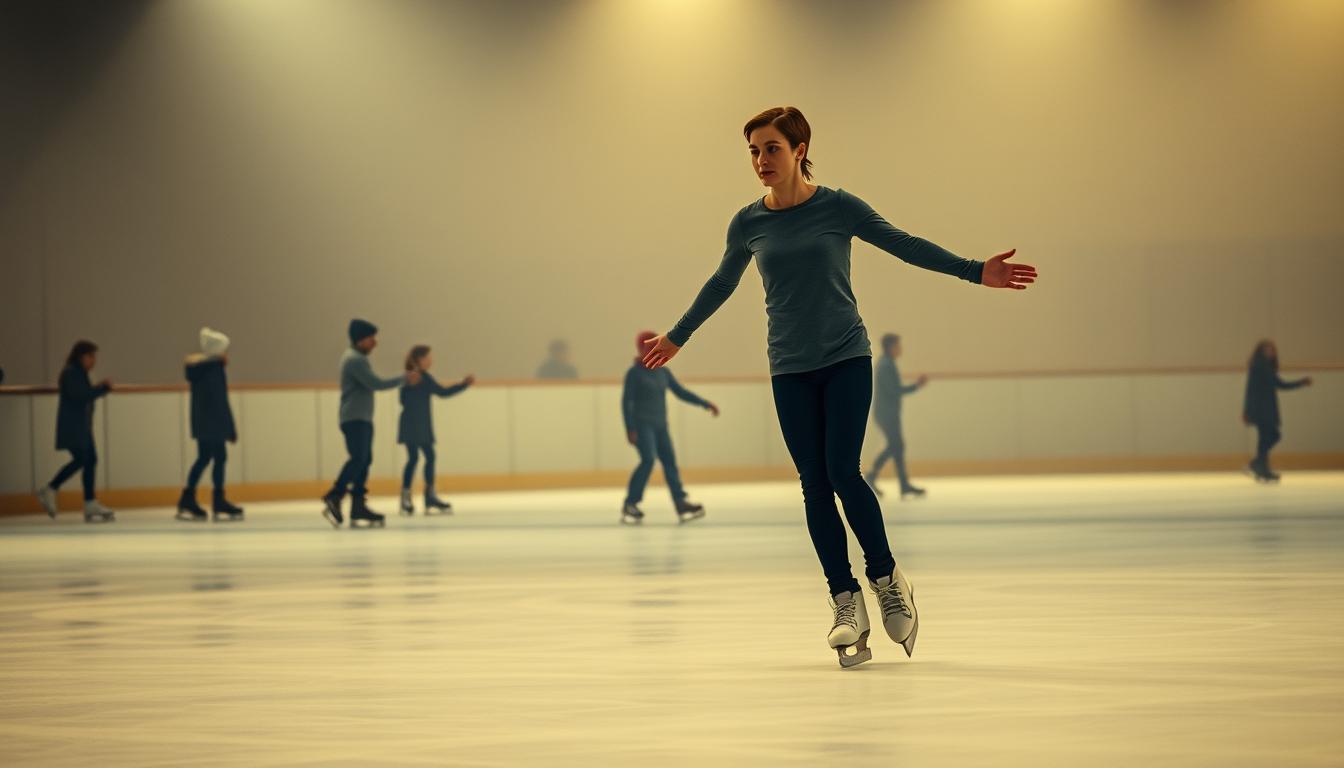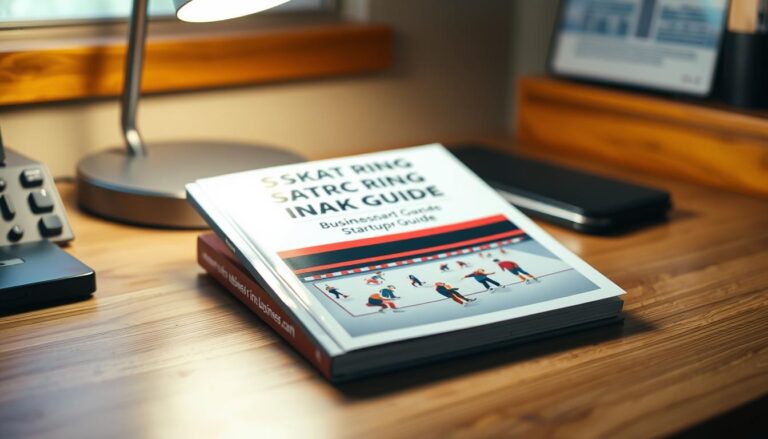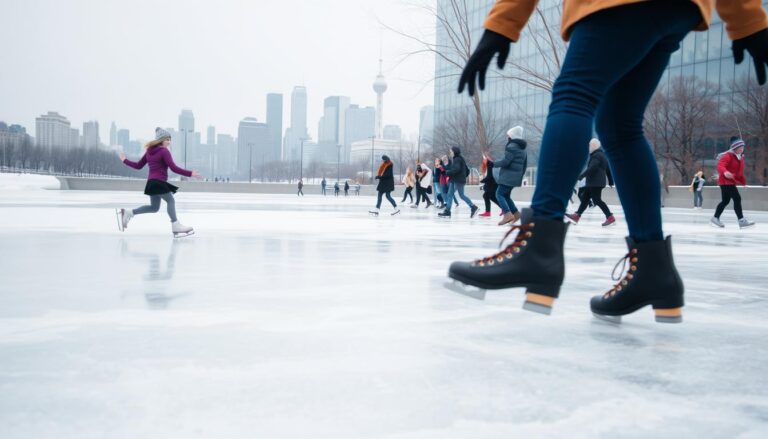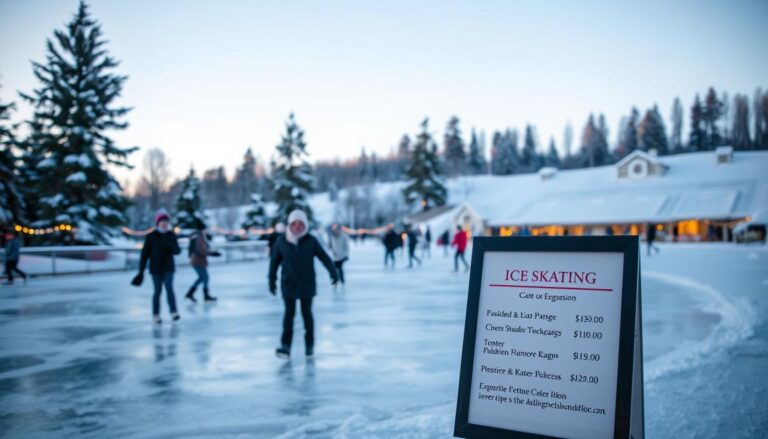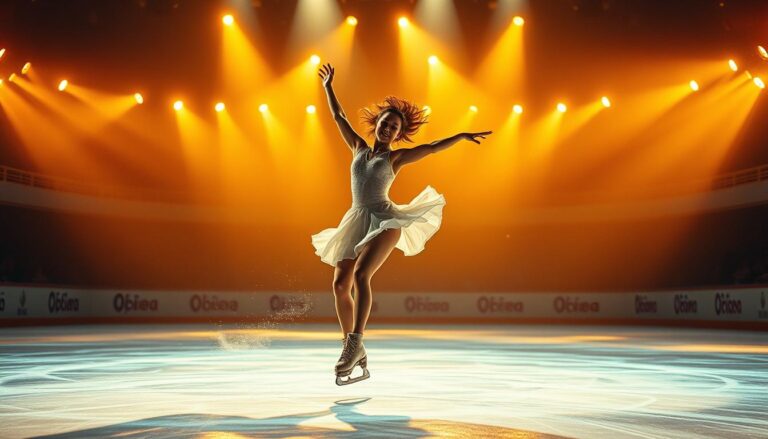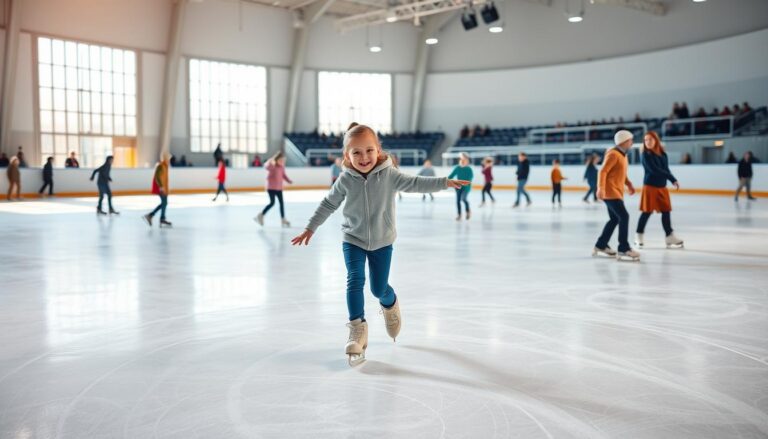How Difficult is Ice Skating? A Beginner’s Guide
Imagine standing at the edge of a shiny ice rink, feeling excited for your first skate. Ice skating might seem tough, but everyone starts at the beginning. They take their first step onto the ice, just like you.
Learning to ice skate is all about breaking it down. It’s not just a sport; it’s a skill that needs balance, coordination, and confidence. How easy or hard it is depends on your athletic level. But, with the right steps, anyone can learn to skate smoothly.
Many think ice skating is too hard for beginners. But, it’s actually quite achievable. Most people can learn basic skating in just a few sessions. With each step, you’ll get better and more confident.
Getting ready physically is key to mastering ice skating. You need strong core, balance, and flexibility. You don’t have to be an athlete to start. Just be ready to learn and practice regularly. Doing some exercises before you skate can really help.
The learning curve for ice skating is easier than you think. Your first time might be tough, but you’ll get the hang of it fast. Experts say to focus on the basics, not speed or fancy moves. Every small step helps you get better.
When you start ice skating, safety is very important. Wear the right gear, get good lessons, and stay positive. Falling is normal, and every good skater has had their share of falls. These falls helped them get better.
Ice skating is great for fun or for getting better at it. Learning the basics makes it more fun. It’s a mix of art and physical challenge that people of all ages and levels enjoy.
Understanding the Basics of Ice Skating
Starting ice skating can be both thrilling and scary for newbies. It’s a great way to have fun or to get better at skating. Learning the basics is key, and it takes patience, practice, and the right way to learn.
Essential Equipment for Starting Out
Getting the right gear is your first step in ice skating. The most important thing is your skates. Here’s what you need to know:
- Choose skates that fit snugly but aren’t painfully tight
- Opt for rental skates initially to test your interest
- Invest in padded socks for comfort
| Equipment | Recommended for Beginners | Cost Range |
|---|---|---|
| Ice Skates | Comfortable, supportive fit | $50-$150 |
| Protective Gear | Helmet, wrist guards, knee pads | $30-$80 |
| Warm Clothing | Layers, flexible movement | $50-$100 |
Proper Skating Posture Fundamentals
Getting the right stance is key for beginners. Keep your knees slightly bent, weight centered, and arms relaxed. This stance helps you stay stable and move smoothly on the ice.
Safety Measures for Beginners
Always put safety first when learning to skate. Wear protective gear, start near the rink’s wall for support, and take lessons from a qualified instructor. They can teach you the right techniques and boost your confidence.
- Always wear a helmet
- Learn fall recovery techniques
- Practice on well-maintained ice surfaces
- Skate within your skill level
How Hard is Ice Skating for Complete Beginners
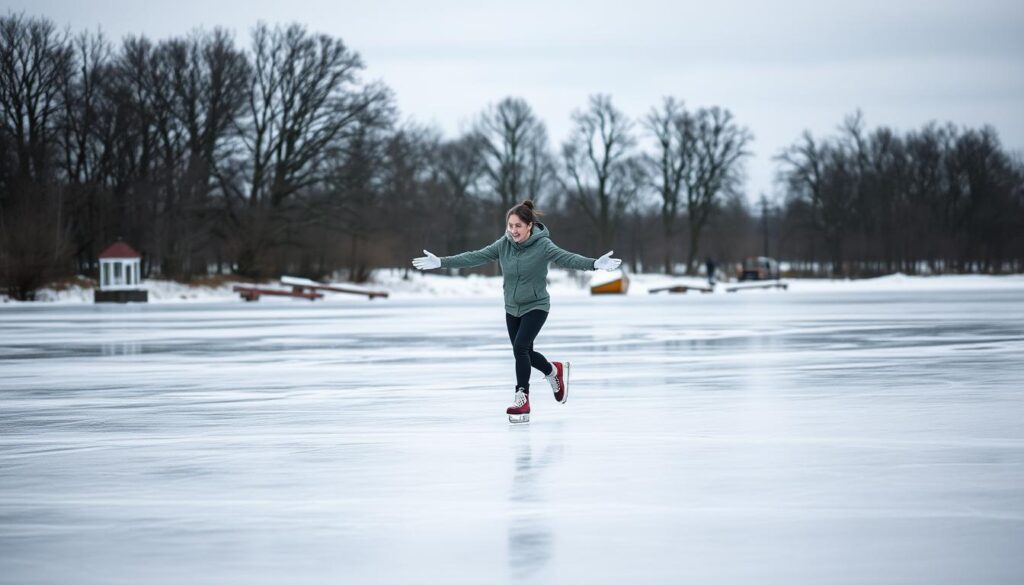
Ice skating might seem hard for newbies, but it’s easier than you think. The difficulty depends on a few key things that affect your first time.
When you first get on the ice, you’ll face three main challenges:
- Balance and coordination
- Muscle adaptation
- Mental confidence
Ice skating requires using muscles you’re not used to. Your legs, core, and ankles will work in new ways. Expect some initial wobbling – it’s normal and part of learning.
How hard ice skating is can vary based on your athletic background. Those with strong cores and good balance learn faster. Recreational skaters progress at their own pace.
Here are some tips for new skaters:
- Wear skates that fit well
- Take beginner lessons
- Practice good techniques
- Stay positive
Experts say to see ice skating as a journey of skill-building. Your first tries might feel awkward, but with practice, they become fun.
Keep in mind, everyone learns at their own pace. Some pick up skating quickly, while others need more time. The key is to enjoy the learning and keep improving.
Physical Requirements and Fitness Levels
Mastering ice skating is more than just wanting to do it. Your physical shape is key to learning fast and well. Knowing what it takes physically can help you get better on the ice.
Core Strength and Balance
Having a strong core is essential for ice skating. It helps you stay stable and move with precision. Skaters with strong cores can:
- Maintain better posture on the ice
- Reduce risk of falls
- Perform more advanced ice skating techniques with greater control
Flexibility and Endurance Needs
Being flexible makes your skating better. More flexibility means smoother, more elegant moves. You also need endurance. Skating is hard on your heart and muscles.
Recommended Pre-skating Exercises
Get ready for ice skating with these exercises:
- Planks for core stability
- Lunges to improve leg strength
- Dynamic stretching routines
- Cardiovascular training like running or cycling
Working on these areas will help you become a confident and skilled ice skater.
First Steps on Ice: What to Expect
Stepping onto the ice for the first time can feel both exciting and intimidating. Learning ice skating requires courage and a willingness to embrace new experiences. The smooth, slippery surface might seem challenging at first, but with the right approach, you’ll quickly build confidence in your beginner ice skating skills.
Your initial moments on the ice will be about understanding balance and movement. Start by wearing comfortable, layered clothing and ensuring your skates fit snugly. Recommended first steps include:
- Holding onto the rink wall for support
- Practicing the marching technique to gain stability
- Keeping your knees slightly bent
- Looking forward, not down at your feet
Many beginners feel nervous about falling, which is completely normal. Professional instructors recommend adopting a relaxed stance and understanding that falls are part of the learning process. Protective gear like helmets and padded shorts can help boost your confidence.
The key to successful learning ice skating is patience and consistent practice. Don’t get discouraged by initial wobbles—every professional skater started exactly where you are now. Focus on small, incremental improvements and celebrate each milestone along your skating journey.
Common Challenges for New Skaters
Ice skating can be tough for beginners, but it’s not impossible. With the right attitude and practice, you can turn these challenges into chances to grow. Learning to skate takes time, patience, and a willingness to learn.
New skaters face many challenges that might seem scary at first. Knowing these challenges is the first step to beating them and feeling more confident on the ice.
Overcoming Fear and Building Confidence
Fear is a big obstacle for new skaters. Here are some tips to help you build confidence:
- Take deep breaths and stay positive
- Practice near the rink’s edge for support
- Wear protective gear to feel safer
- Set small, achievable goals
Managing Balance Issues
Balance is key in ice skating. To improve your balance, try these techniques:
| Balance Technique | Practice Method |
|---|---|
| Body Alignment | Keep knees slightly bent, weight centered |
| Core Strength | Practice off-ice exercises like planks |
| Visual Focus | Look ahead, not down at your feet |
Dealing with Falls and Recovery
Falling is part of learning to skate. The key is learning how to fall safely and recover quickly. Here’s how to fall without getting hurt:
- Bend knees and keep arms close to body
- Avoid using hands to break a fall
- Roll to the side if possible
- Practice getting up smoothly
Remember, every pro skater started where you are now. Enjoy the learning process, be patient with yourself, and have fun mastering ice skating.
Essential Ice Skating Techniques for Beginners

Learning ice skating takes time and effort. Beginners need to grasp basic skills to feel confident on the ice. Mastering these techniques helps you glide smoothly and safely, making the experience fun.
Here are the key skills for beginners to become confident skaters:
- Basic Standing and Balance
- Push and Glide Technique
- Stopping Methods
- Weight Shifting
- Basic Turning
Understanding your body’s position is key. Beginners should keep knees slightly bent, back straight, and arms relaxed. This stance helps you stay balanced and avoid falls.
Key Skating Movements
| Technique | Difficulty Level | Practice Tips |
|---|---|---|
| Push and Glide | Beginner | Start with small, controlled pushes |
| Snowplow Stop | Beginner | Practice on soft ice with protective gear |
| Forward Crossovers | Intermediate | Learn weight transfer gradually |
Building strong skating skills takes regular practice. Start slow, focus on your balance, and gradually build confidence. Remember, every pro started where you are now, learning the basics with determination.
Don’t worry about falling at first. It’s part of learning. Each fall teaches you more about balance and control on the ice.
Learning Curve and Progress Timeline
Learning to ice skate is a journey full of challenges and rewards. Your progress depends on how often you practice, your natural ability, and how committed you are. Knowing the learning curve helps you set goals and stay motivated.
Ice skating takes patience and regular practice. Beginners go through stages that turn shaky starts into smooth glides.
Skill Development Stages
- Beginner Stage (Weeks 1-4)
- Basic balance and standing on ice
- Learning fundamental forward movement
- Understanding proper skating posture
- Intermediate Stage (Months 2-6)
- Improved balance and controlled stopping
- Basic turning techniques
- Enhanced confidence on the ice
- Advanced Beginner Stage (Months 6-12)
- Smoother skating movements
- Introduction to crossovers
- Basic backward skating
Setting Realistic Goals
| Skill Level | Typical Time Investment | Expected Progression |
|---|---|---|
| Complete Novice | 1-2 hours/week | Basic balance and movement |
| Consistent Learner | 3-4 hours/week | Controlled skating, basic techniques |
| Dedicated Skater | 5-6 hours/week | Advanced techniques, increased confidence |
Everyone learns at their own pace. Celebrate your small wins, be patient with yourself, and enjoy the journey. Your progress is unique to you.
Best Practices for Learning Ice Skating
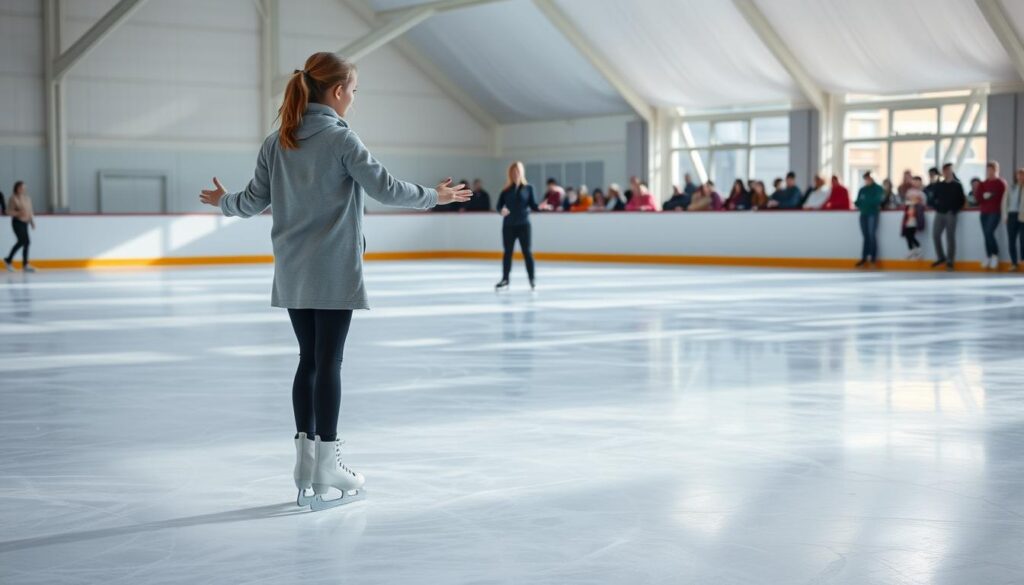
Learning ice skating is more than just stepping onto the rink. It’s about strategic practice and smart learning. These can help you progress faster and feel more confident on the ice.
For beginners, starting with a consistent practice routine is key. Short, regular sessions are better than long, rare ones. Try to practice for 30-45 minutes, 2-3 times a week. This helps build muscle memory and skills.
- Watch experienced skaters and learn from their techniques
- Practice visualization techniques off the ice
- Focus on proper warm-up and cool-down routines
- Record your progress with video analysis
Mental preparation is also important. Visualization can improve your skills even when you’re not skating. Imagine yourself moving smoothly and balancing well.
Here are some key tips for beginners:
- Start with proper skating posture
- Learn basic stopping techniques
- Practice falling safely
- Build core strength and balance
Pro tip: Don’t fear falling. It’s an essential part of learning and building confidence on the ice.
Remember, progress takes time. Stay patient, keep practicing, and celebrate your small wins. Enjoy your journey on the ice.
Different Types of Ice Skating Disciplines
Ice skating is a world full of different disciplines for all interests and skill levels. It’s not just about gliding on ice. Each discipline offers unique challenges and fun experiences for everyone.
Ice skating techniques go beyond just gliding. You can pick from many disciplines that fit your goals and what you enjoy doing.
Figure Skating Basics
Figure skating is the artistic side of ice skating. Skaters work on elegant moves, detailed footwork, and amazing jumps. Key parts include:
- Precise edge control
- Choreographed routines
- Jumps and spins
- Artistic expression
Recreational Skating Skills
Recreational skating is great for a fun workout. It’s a good start for beginners. It helps build confidence and lets you enjoy the sport without competition.
| Discipline | Skill Level | Primary Focus |
|---|---|---|
| Figure Skating | Intermediate to Advanced | Artistic Performance |
| Recreational Skating | Beginner to All Levels | Enjoyment and Fitness |
| Speed Skating | Advanced | Racing and Velocity |
Whether you love graceful performances or just want to have fun on the ice, there’s a discipline for you. Explore and master the one that suits you best.
Finding the Right Instruction and Support

Learning ice skating can be tough without the right help. Professional teachers make your journey fun and easy. They help you learn the right way from the start.
When looking for ice skating lessons, keep these points in mind:
- Instructor qualifications and experience
- Teaching style and communication skills
- Program structure for ice skating for beginners
- Class size and individual attention
Group classes have many benefits for beginners. They offer:
- Cost-effective learning environment
- Opportunity to meet other skating enthusiasts
- Structured curriculum for skill progression
- Motivational group dynamics
Private lessons might be ideal if you need personalized attention or want to accelerate your learning curve. Certified instructors can help you build confidence, correct technical mistakes, and develop proper skating techniques tailored to your skill level.
Local skating clubs are great for beginners. They provide:
- Regular practice sessions
- Skill workshops
- Community support
- Access to experienced skaters
When choosing an instruction program, research local rinks, read reviews, and don’t hesitate to ask for trial lessons. Your commitment to finding the right support will significantly impact your ice skating journey.
Common Mistakes to Avoid When Starting Out
Learning ice skating can be tough. New skaters often face obstacles that slow them down. Knowing these challenges early helps you skate better and feel more confident.
Ice skating is a world that needs focus and effort. Beginners often make mistakes that slow them down. Let’s look at some common errors and how to fix them.
Technical Errors to Watch For
- Looking down at your feet instead of ahead
- Keeping your body too stiff and rigid
- Incorrect weight distribution on skates
- Improper knee bend and ankle alignment
These tips can really help your skating. Maintaining proper posture and focus is key for smooth skating.
Bad Habits That Slow Progress
| Bad Habit | Impact on Skating | Recommended Solution |
|---|---|---|
| Overreliance on Rink Wall | Limits independent movement | Practice balance exercises off-ice |
| Neglecting Weaker Side | Creates uneven skill development | Dedicate practice time to both sides |
| Tensing Up When Falling | Increases injury risk | Learn proper falling techniques |
Knowing these challenges helps you learn better. Experts say to build skills slowly and stay positive and relaxed.
Progressing Beyond the Basics
Mastering ice skating is a journey that never ends. Once you’ve learned the basics, you’re ready for more. This is when you start to see real growth in your skills.
As you move forward, there are key areas to focus on. You’ll learn new skills that build on what you already know. This is how you get better.
- Backward skating with confident control
- Advanced stopping methods
- Introduction to basic jumps and spins
- Enhanced edge work and balance
Getting better at ice skating takes practice and focus. You should aim to improve little by little. Always keep your form right and stay safe.
| Skill Level | Key Focus Areas | Practice Frequency |
|---|---|---|
| Intermediate | Edge control, backward skating | 2-3 times per week |
| Advanced Beginner | Basic jumps, crossovers | 3-4 times per week |
Working out off the ice is also important. Exercises that boost your core, flexibility, and balance help you skate better.
- Strength training for lower body
- Flexibility exercises
- Balance and coordination drills
Remember, advancing in ice skating is a personal journey. Each skater progresses at their own pace, celebrating small victories and continuously challenging themselves.
Conclusion
Learning to ice skate is all about getting better, not being perfect right away. Everyone starts by taking small steps and finding their balance. As you get more comfortable, you’ll feel more confident and skilled.
Ice skating is more than just moving your body. It’s about pushing yourself, getting to know your body, and finding your own way to express yourself. The tough times you face are just the beginning of your growth as a skater.
Remember, becoming great takes time. Even pros and hobbyists started where you are now. Your path will be filled with small wins, stumbles, and moments of pure happiness as you master the ice.
Your skating journey is just starting. Enjoy every practice, be kind to yourself, and have fun learning. Whether you skate for fun or to compete, the key is to enjoy the ride. The ice is ready, and your possibilities are endless.
